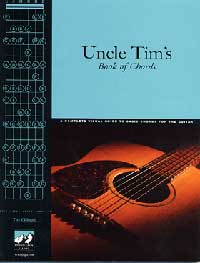

Keys Are The Sure Way To Build Songs!
Keys seem to be the hidden ingredient to playing a guitar. Once you know keys you can immediately start playing the chords in the key and constructing songs based on the chords in the key.
Triads are the simplest chords you can create and they flow up and down the fretboard providing easy access to any chord in any key with hardly any effort.
And when you are constructing a song, there is no better tool available anywhere. And the knowledge you get will set you free!
There is nothing like it and nothing that can make composing songs as easy as this. For $20, you can have a resource that will always show you all the choices for where you are working. Pick up a copy today.
eBooks are delivered instantly!
Example Number 1
This is a simple warm-up exercise centered around becoming familiar with different patterns that are found right on top of one another in the diatonic signature.
The first scale run is a simple open string scale in the key of C major.
The second run is a good example of a pattern that is created by taking parts of adjacent patterns.
The third pattern is an example of a typical big stretch pattern that I use all over the fretboard for every key. The second pattern is a hybrid of the first and third patterns. The intent of this exercise is to become familiar with adding and subtracting notes to create pathways that are flexible and allow you to move wherever you need to be.
There are many more examples of these types of hybrids. If you continue to play these and start to look for others you will unleash the true power of the diatonic signature.
Example Number 2
This is a simple triad run using basic triads for the key of C major and A minor.
These triads start on the lowest three strings and proceed up and across the fretboard. They are a useful exercise for getting acquainted with chords in the key of C. They are also a useful tool for improving your ability to form different chord forms and train your fingers to play on demand.
I suggest starting by just strumming these chords or plucking them using your fingers. As you develop a feel for them, try to play arpeggios and more advanced finger picking.
Also be aware there are different places to play these exact chords so you do not have to limit yourself to the exact locations shown in these examples. Sometimes the stretch necessary to play them is quite demanding as you will see in the next example. So feel free to switch string sets if it is easier. Just make sure you are playing the exact same notes as shown.
Example Number 2 with no stops
Example Number 3
This example uses seventh triads in the first inversion. After playing through the last example, you may find the sound of these slightly more interesting.
They are created using the one, third and seventh degrees which will form a basic seventh triad. The fifth degree is left out because it really does not add much to the chord. The first degree provides the root note while the third degree determines if the chord is major or minor. The seventh degree creates the seventh chord.
The stretch needed to play these is slightly harder than the last example, so substitution may become necessary if your hands are not used to these large stretches.
Example Number 3 with no stops.